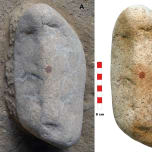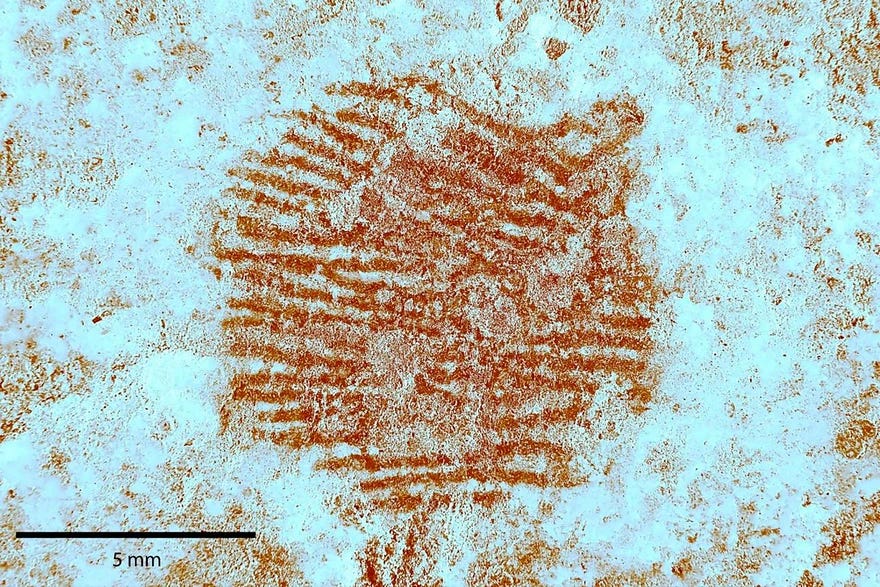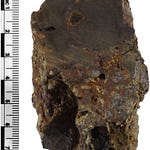The Face in the Rock Shelter
In the shadowy rock shelters of the Eresma River valley in central Spain, a curious stone was discovered in 2022—one that would go on to challenge deeply ingrained assumptions about the cognitive lives of Neanderthals.
The object, a quartz-rich pebble about the size of a melon, bore three naturally formed indentations. But what set it apart was a vivid red dot of ochre placed with startling precision on its surface. Nestled between these cup-like depressions—where the "nose" might lie if this stone were, say, a face—the pigment was later revealed to contain something extraordinary: the oldest known human fingerprint1 in Europe, and likely the earliest associated with the deliberate use of pigment.

At over 43,000 years old, this wasn't just pigment on stone. It may have been a gesture of recognition, a marking of meaning, or something altogether more mysterious.
“The fact that the pebble was selected because of its appearance and then marked with ochre shows that there was a human mind capable of symbolising, imagining, idealising and projecting thoughts on an object,” the research team writes.
Hominin Hallmarks: Symbolism in Stone
This pebble wasn’t shaped into a tool. It bore no wear marks typical of hammerstones or grinding implements. Instead, its form seemed to have attracted attention for a subtler reason: its resemblance to a human face.
The three depressions—two smaller ones and a larger irregular one—suggested eyes and a mouth. Positioned centrally between them, the red ochre fingerprint added what could be interpreted as a nose. Statistical analysis revealed that this red dot was placed in a location unlikely to be the result of chance. The researchers calculated a mere 0.31% probability that such a placement happened accidentally.
While face-like shapes in natural objects—what psychologists call pareidolia—are common, the deliberate application of pigment to enhance or complete such a perceived image marks a significant leap.
“Could the morphology of the piece, with the presence of three cupules on the same surface and the positioning of the red dot in relation to them, represent a composition explained by the phenomenon of pareidolia?” the researchers ask.
If so, this is one of the oldest known examples of a Neanderthal engaging with that pattern-recognition impulse that modern humans also exhibit: seeing faces in clouds, tree bark, or rocks—and then responding with symbolic action.
The Science of a Smudge
To investigate the mark’s origin, the team employed multispectral imaging, X-ray fluorescence, 3D scanning, and scanning electron microscopy. The pigment was identified as ochre—a mix of iron oxides and clay minerals—distinct from the surrounding cave sediments and imported from elsewhere. More importantly, the print bore dermatoglyphic characteristics that allowed forensic specialists to determine it was human, likely from an adult male.
This wasn’t the only pigment-marked object known from Neanderthal sites, but its clarity, context, and fingerprint make it unique.
The researchers ruled out incidental contact—such as a ochre-stained hand brushing the pebble while using it—since the stone showed no wear or utilitarian features. Moreover, no other ochre traces were found in the cave’s archaeological layer, suggesting this was not a byproduct of some larger activity like ochre processing.
“The red dot is not placed randomly and appears to clearly reflect a deliberate action,” the authors write. “If there is action and planning involved, it cannot be ruled out that this might constitute a visual sign.”
Neanderthal Minds at Work
The pebble emerged from a Mousterian context (Level H) associated exclusively with Homo neanderthalensis—predating any evidence of Homo sapiens in the region. Its age and context are securely dated via radiocarbon analysis of nearby horse teeth to between 43,500 and 42,100 years ago.
This temporal window, shortly before Neanderthals vanished from the Iberian Peninsula, represents some of their final known moments of material expression. And yet, far from brutish toolmakers, they appear here as deliberate actors capable of symbolic abstraction.
The researchers propose that the pebble fits within a broader repertoire of Neanderthal symbolic behavior: engraved bones and pebbles, pigment use, eagle talon adornments, and non-figurative cave marks. The presence of a human fingerprint fused with pigment adds yet another layer—both literally and figuratively—to this expanding picture.
Art or Pareidolia?
Interpreting ancient symbols is notoriously fraught. Is this art? Religion? A doodle? Or simply a curious moment of aesthetic recognition?
Neuroscience tells us that face recognition is deeply embedded in the primate brain. Pareidolia isn’t random—it’s adaptive. In that light, the act of selecting this particular pebble, seeing in it a potential face, and pressing a pigment-laced fingertip to it becomes more than idle play. It becomes an artifact of perception.
And if that interpretation holds, then it may be that Neanderthals, too, looked at a world full of shapes and saw something more.
“If we had a pebble with a red dot on it that was done 5,000 years ago by Homo sapiens,” said lead researcher David Álvarez-Alonso, “no one would hesitate to call it portable art.”
Related Research
Here are additional studies offering context and comparative insight into Neanderthal symbolic behavior and cognition:
Zilhão, J. et al. (2010). Symbolic use of marine shells and mineral pigments by Iberian Neandertals. Proceedings of the National Academy of Sciences, 107(3), 1023–1028. https://doi.org/10.1073/pnas.0914088107
Hoffmann, D. L. et al. (2018). U-Th dating of carbonate crusts reveals Neandertal origin of Iberian cave art. Science, 359(6378), 912–915. https://doi.org/10.1126/science.aap7778
García-Diez, M. & Ochoa, B. (2020). Marks on rocks: Engraved pebbles from the Mousterian site of Axlor (Northern Iberia). Journal of Archaeological Science, 122, 105198. https://doi.org/10.1016/j.jas.2020.105198
Majkić, A. et al. (2018). Symbolic behaviour of Neanderthals: Overview of the archaeological evidence. Cambridge Archaeological Journal, 28(3), 411–437. https://doi.org/10.1017/S0959774318000271
Rodríguez-Vidal, J. et al. (2014). A rock engraving made by Neanderthals in Gibraltar. Proceedings of the National Academy of Sciences, 111(37), 13301–13306. https://doi.org/10.1073/pnas.1411529111
Álvarez-Alonso, D., de Andrés-Herrero, M., Díez-Herrero, A., Miralles-Mosquera, S., Sastre Barrio, M. C., Maté-González, M. Á., Nieva Gómez, E., Díaz Delgado, M. R., & Ruiz Mediavilla, E. (2025). More than a fingerprint on a pebble: A pigment-marked object from San Lázaro rock-shelter in the context of Neanderthal symbolic behavior. Archaeological and Anthropological Sciences, 17(6). https://doi.org/10.1007/s12520-025-02243-1










